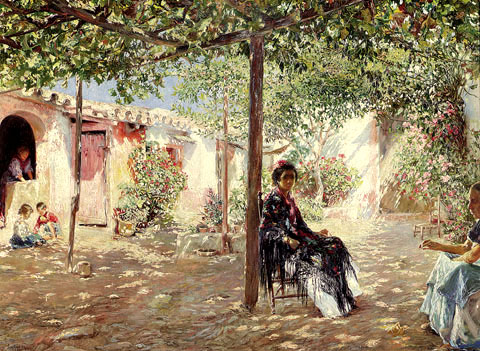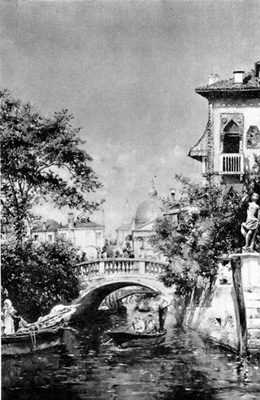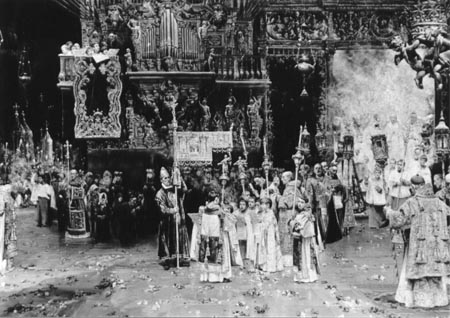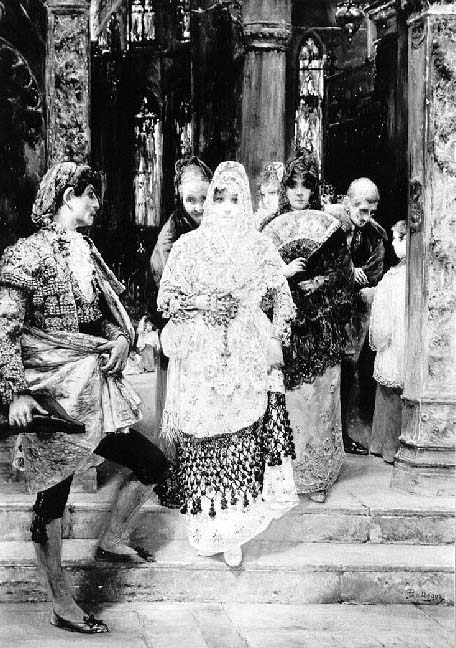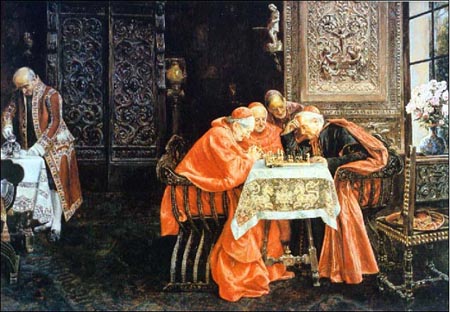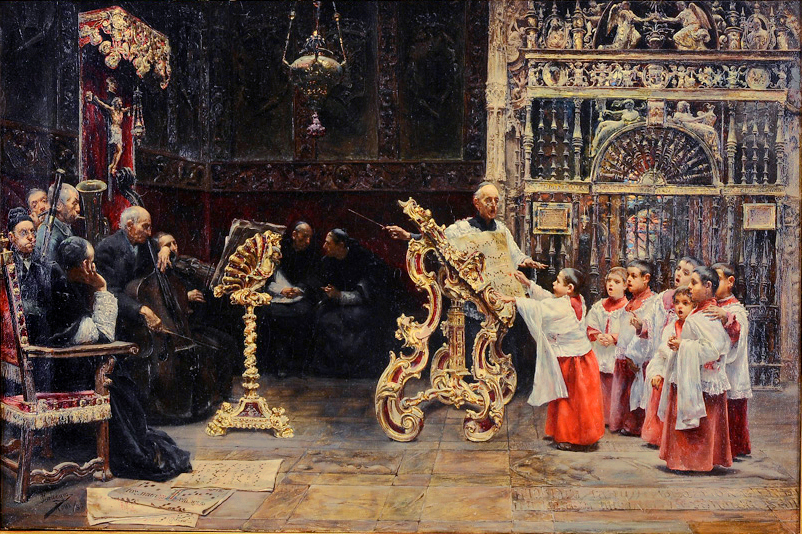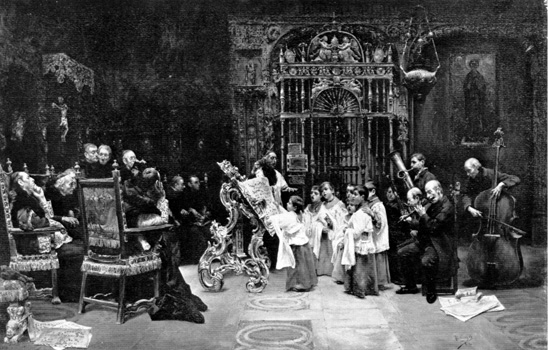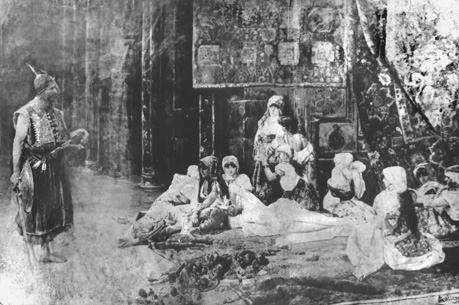Artists Work
Despite the fact that José Gallegos spent most of his life in Italy, the subject matter of many of his pictures was Spanish; this was not only due to the fact that he had spent his earlier life in Spain, but also due to the influence of to his many Spanish friends and fellow artists living in Rome. Furthermore he was stirred by the impressionist movement, and he painted a number of exquisite pictures in this style.
Ladies in a Courtyard represents a Spanish girl and her mother sitting in a shaded courtyard under vines, with brilliant sunlight shining onto two children playing.
Couturières Espagnoles depicts a group of Spanish women sitting under a pergola, sewing and chatting, the rays of sunshine filtering through the vine and illuminating the women’s faces.
José Gallegos also painted Spanish outdoor market and street scenes in this impressionistic style, as well as landscapes of the country around Venice, Rome, and the Gulf of Naples. Often the backgrounds to his portraits were almost pictures in themselves. He loved nature, and he loved painting trees and flowers, always with the emphasis on colour and light. One of his works The Procession of the Cross has such a sense of movement and colour, that the famous Italian art critic, Mario Passage wrote “The procession is so wonderfully powerful and alive, that you can almost hear the choir chanting and smell the incense burning”. Contrast this with Bolero, a group of vivacious girls dancing under a pergola which is covered with creepers and brightly coloured flowers, the strong rays of sunlight penetrating through the leaves. In another version of The Christening a ‘cortège’ dressed in Spanish finery are journeying down a country road lined with brightly coloured trees in blossom. All Souls Day in Rome shows flower stalls covered with the finest varieties of chrysanthemums, and a poor old woman buying a bunch of flowers for her lost loved one with her last few liras.
View in Venice is of a quiet canal in Venice, but this painting now showing the transition from pure Impressionism to the intricate detail of which we are to see so much in his later paintings. The Game of Cards was also painted in this period, and clearly demonstrates the transition.
So much for his impressionistic works; but the subjects for which he is best known, and which he painted profusely were of another kind. These were the dark interiors of Spanish cathedrals, Italian Renaissance churches, and Moorish buildings in the Spanish interior; of religious processions and Christian rituals. These are the paintings of the elaborate costumes and the brilliant light effects, which confirm the skill, and the dedication of the painter whose architectural and scenic mastery come together so harmoniously. After the Corrida shows the torreadors in their rich and multi-coloured costumes going to the cathedral to give thanks that their lives had been spared; The Hour of Prayer depicts a group of devout parishioners going through the entrance door of a church bathed in sunshine, and into the dark interior lit only by the stained-glass windows.
The Feast of the Madonna must also be mentioned here, as being amongst the most important of his paintings. This picture is of the interior of Seville cathedral, and is of a blaze of colour and light, and of a wonderful sense of movement. Here one sees the fantastic attention to detail that so characterised his religious paintings.
In Le Mariage, which is in the same style, one sees the play of light on the bride and on the groom’s face, but this time they are coming out of the basilica and away from the dimly lit interior into the bright sunlight of a Spanish summer day. And so this Spanish painter manages to capture at one and the same time the burning midday sun of Spain, and the icy mediaeval chill that greets one on first entering a Spanish cathedral in Andalucia.
In his later period, however, his paintings became less flamboyant; they were generally smaller, exquisitely painted, and often represented church dignitaries. Two paintings entitled A Game of Chess are illustrated here. In the first two cardinals are playing chess, one deeply entrenched in the next move whilst the second is more concerned with the quality of his tea. The second painting of four cardinals grouped together around a chess board is as carefully composed as any Italian painting of the classical tradition. The bright reds of the cardinals robes contrasting with the blackened wood panelling, and all this executed with the most meticulousattention to detail.
In The Harem, a soldier guards the attendant Moorish girls. From photographs of José Gallegos’ studio we can recognise the tapestry in the background. This painting was executed in 1882, and surprisingly was already in the period when he was predominantly working on religious subjects. José Gallegos’ work will always be distinguished by his three outstanding qualities; his superb technique for detail, his masterful composition, and his insuperable sense of colour.
Here is a quotation about José Gallegos y Arnosa from an article written in an Italian art review by Corrado Trelanzi:
“….the Spanish character of this painter’s works reveals itself to us in the richness of his compositions, in the intenseness of his subject matters, and in the warm tones that dominate each work. Being an admirer of the French Impressionist movement from his early days, as can be seen by the few paintings remaining from his youth, José Gallegos then fell under the influence of the artistic temperament of 19th century Italy, and through his close contact with the celebrated painters of the day (Mancini, Michetti, and others), arrived at his own personal expression, dominated by the traditions and religious influences of his native Spain.”
“…His preferred subject matters remained the interiors of the great Spanish cathedrals, of Moorish edifices, and of Italian Baroque churches; Religious processions; harmony of movement in which the people in their splendid costumes take pride of place, always
emphasised by his the subtle handling of light.
All this confirmed the personality and the solidity of this painter’s gifts of architect, set designer, and draughtsman; the whole is then united together by his mastery of choice of colour, and by his sure brushstroke. He loved diversifying into the minutest detail, with the skill of a great miniaturist.
To remember José Gallegos means turning one’s thoughts towards an artist with a passion that could only come from the sensitivity of a noble Spanish soul, who fell for the charm of Rome, and who Rome loved like one of its own.”
